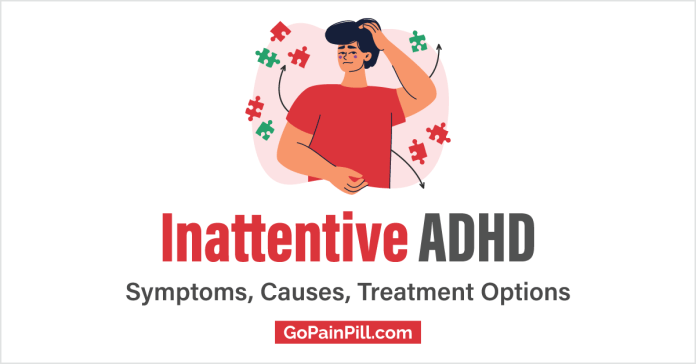Attention Deficit Hyperactivity Disorder (ADHD) is a complex neurodevelopmental condition that affects individuals of all ages. While some people may associate ADHD with hyperactivity and impulsivity, there is another form of the disorder called the inattentive type of ADHD, also known as ADHD predominantly inattentive presentation.
This subtype is often misunderstood, leading to underdiagnosis and delayed intervention.
In this article, we will delve into the inattentive type of ADHD, exploring its characteristics, causes, and effective management strategies.
What is Inattentive Type of ADHD?

The inattentive type of ADHD primarily affects an individual’s ability to focus and sustain attention. Unlike the hyperactive-impulsive presentation of ADHD, individuals with the inattentive type may not display obvious signs of restlessness or impulsivity.
As a result, this form of ADHD often goes unnoticed, particularly in quiet or well-behaved individuals.
Symptoms of Inattentive Type ADHD
The symptoms of inattentive ADHD are not as overt as those seen in other forms of the disorder. Common signs include:
- Difficulty Paying Attention: Individuals may struggle to concentrate on tasks or conversations, frequently becoming easily distracted by external stimuli.
- Poor Organization Skills: Disorganization and forgetfulness are common, leading to missed deadlines and misplaced belongings.
- Inability to Follow Through: Despite good intentions, individuals may find it challenging to complete tasks or follow through on responsibilities.
- Lack of Attention to Detail: Failing to notice crucial details or making careless mistakes is a characteristic feature of inattentive ADHD.
- Avoidance of Mentally Demanding Tasks: Individuals may shy away from tasks that require sustained mental effort, finding them overwhelming.
- Frequent Daydreaming: An excessive amount of daydreaming or spacing out can be observed.
Causes of Inattentive Type ADHD
The exact causes of inattentive ADHD, like other forms of the disorder, are not fully understood. However, several factors are believed to contribute to its development:
- Genetic Predisposition: Family history plays a significant role in the likelihood of developing ADHD. Individuals with a family member diagnosed with ADHD may have a higher risk of developing the inattentive type.
- Neurobiological Factors: Differences in brain structure and function, particularly in regions responsible for attention and executive function, may contribute to inattentive ADHD.
- Chemical Imbalance: Neurotransmitters like dopamine and norepinephrine play crucial roles in attention regulation. Any imbalance in these neurotransmitters may affect attention span.
Diagnosing Inattentive Type ADHD
Diagnosing inattentive type ADHD requires a comprehensive evaluation by a qualified healthcare professional. This typically involves:
- Medical History: A detailed medical history is essential in identifying any underlying medical conditions or family history of ADHD.
- Observation and Behavior Analysis: Parents, teachers, or caregivers may be asked to provide information about the individual’s behavior and symptoms in different settings.
- Rating Scales and Questionnaires: Standardized rating scales and questionnaires are used to assess the severity of ADHD symptoms and their impact on daily life.
- Exclusion of Other Conditions: Other medical or psychological conditions that can mimic ADHD symptoms must be ruled out before a definitive diagnosis is made.
Management and Treatment
Effective management of inattentive type ADHD involves a multi-faceted approach, tailored to the individual’s specific needs. Some essential components of management include:
- Behavioral Therapy: Behavioral therapy, such as Cognitive Behavioral Therapy (CBT), can help individuals develop coping mechanisms and organizational skills to manage symptoms effectively.
- Educational Support: Collaborating with educators to implement strategies, such as extra time for assignments, can accommodate an individual’s attention difficulties in educational settings.
- Medication: In some cases, medication may be prescribed to help improve attention and concentration. Stimulant medications, such as methylphenidate, are commonly used for ADHD management.
- Parent and Teacher Involvement: Parents and teachers play vital roles in supporting individuals with inattentive ADHD. Consistent communication and mutual understanding can significantly aid the management process.
Lifestyle Tips for Individuals with Inattentive ADHD
Beyond formal treatment, lifestyle adjustments can significantly enhance the overall well-being of individuals with inattentive ADHD:
- Establishing Routines: Creating consistent daily routines can help individuals better organize their tasks and responsibilities.
- Minimizing Distractions: Reducing external distractions in the environment can promote better focus and attention.
- Break Tasks into Smaller Steps: Breaking down tasks into manageable steps can make them feel less overwhelming and more achievable.
- Regular Exercise: Engaging in physical activities can help reduce restlessness and improve overall mental well-being.
FAQs
1. Can inattentive type ADHD be outgrown?
ADHD is a chronic condition, but symptoms can change over time. Some individuals may find that their symptoms become less noticeable or more manageable as they learn coping strategies and mature. However, it is essential to seek appropriate management and support throughout life.
2. Is inattentive type ADHD more common in girls or boys?
Inattentive type ADHD is often more commonly diagnosed in girls, as their symptoms may be less disruptive and more easily overlooked than the hyperactive-impulsive type.
3. Can adults have inattentive type ADHD?
Yes, ADHD can persist into adulthood, and individuals who had inattentive type ADHD as children may continue to experience symptoms in their adult years.
4. Is medication the only treatment for inattentive type ADHD?
No, medication is not the only treatment option for inattentive type ADHD. Behavioral therapy, lifestyle adjustments, and educational support are equally important in managing symptoms effectively.
5. Can a child have both inattentive and hyperactive-impulsive type ADHD?
Yes, some individuals may have a combination of symptoms from both inattentive and hyperactive-impulsive type ADHD, leading to a diagnosis of combined presentation ADHD.
Conclusion
The inattentive type of ADHD, also known as ADHD predominantly inattentive presentation, is a distinct form of ADHD that primarily affects an individual’s attention and focus. Recognizing the subtle symptoms and providing appropriate support and intervention is crucial in helping individuals with inattentive ADHD lead fulfilling lives.
A combination of behavioral therapy, educational support, and lifestyle adjustments can make a significant positive impact on managing the symptoms and improving overall functioning for those with inattentive type ADHD.
